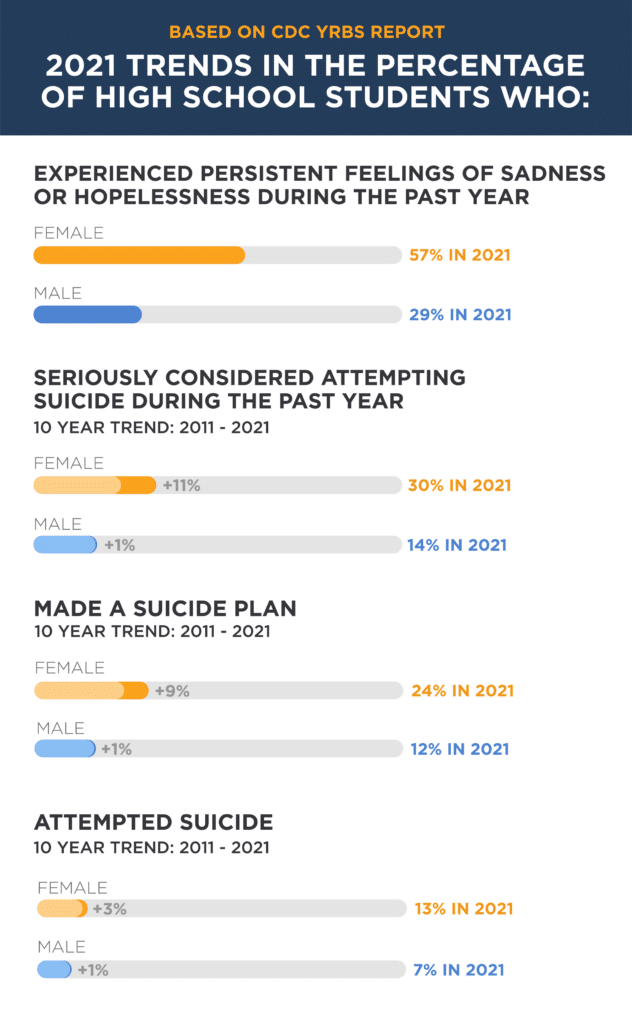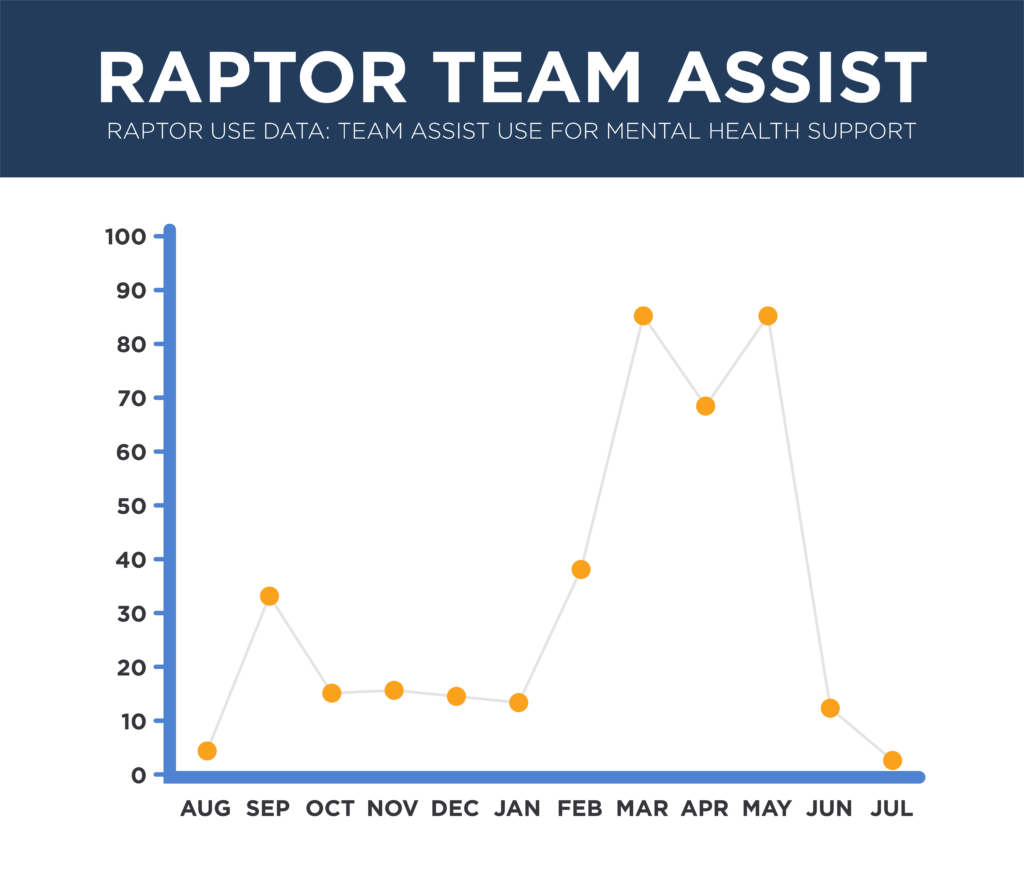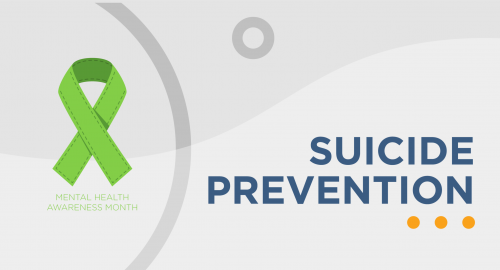Listen to this blog
4 minutes
On February 13, the Centers for Disease Control and Prevention (CDC) released their Youth Risk Behavior Survey (YRBS) report. Based on data collected every two years, this survey provides insight into key health behaviors and experiences that impact students’ wellbeing and includes data trends related to mental health and youth suicide.
This report is particularly noteworthy because its data was collected in fall of 2021, making it the first such report to include data related to the mental health impact of Covid-19. It also includes trends showing concerning data when it comes particularly to the wellness and safety of our female students as well as that of LGBTQ+ students.

According to the CDC, suicide is the second leading cause of death of children over 10 in the United States—that rates have been increasing in recent years.
Schools are in a unique position to identify and support students who may be at risk.
Suicide risk assessments help schools identify students who may be experiencing suicidal thoughts or behaviors and provide them with the support and resources they need to stay safe.
With the implementation of patented StudentSafe™ technology, school counselors and mental health professionals can gain a significant advantage by having immediate access to a student’s complete chronology within the system. Authorized staff can swiftly access a student’s history of previous concerns, suicide risk assessments, interventions, progress, and other important information, whether an assessment is initiated directly or escalated from a concern. This feature facilitates the identification of underlying factors that contribute to self-harm behaviors, enabling earlier and more effective interventions.
Building a Culture of Safety and Support
The following graphic captures how Raptor’s Team Assist tool is used by school staff seeking assistance with a student in need of mental health-related interventions.

A strong and supportive community can provide a sense of belonging and connection, which can be crucial for individuals who may be struggling with mental health issues or suicidal thoughts. But creating a safe and supportive environment for students requires intentional guidance and effort from leaders in the school community.
Here are some ways that communities can build a community that better supports students’ wellbeing:
- Mental health services
Access to mental health services is essential for suicide prevention. Communities can provide resources such as counseling services, support groups, and crisis hotlines to ensure that individuals have access to the help they need. - Peer support
Peer support can be a powerful tool for suicide prevention. Communities can establish peer support groups and clubs for individuals who may be struggling with mental health issues or suicidal thoughts. These groups can provide a sense of belonging and connection and can help individuals feel less alone.
Schools should also review anti-bullying policies and make sure they clearly define what bullying is as well as reporting procedures and consequences. - Community events
Promoting social connectedness and reduce isolation are important factors in suicide prevention. Communities can hold events such as block parties, community festivals, and other activities that encourage social interaction and engagement. - Education and awareness
Mental health education programs and awareness campaigns provide information about warning signs, coping strategies, and available resources. By being better informed, students can better recognize concerning behavior—and know how to reach out for help. - Policies and protocols
Establish protocols for responding to mental health crises and provide training for teachers, staff, and community members on suicide prevention. Appropriate training means your staff will be better prepared to recognize wellness concerns, respond to misbehavior related to unmet mental health needs, and report those concerns—thus improving the wellbeing of your students.
Providing Resources for Suicide Prevention
Preventing suicide requires a multifaceted approach that addresses the root causes of suicidal behavior and provides support to those who may be struggling. Here are some strategies that can help prevent suicide among students:
Professional help
One of the most effective ways to prevent suicide is to seek professional help from mental health experts. This may include talking to a therapist, counselor, or psychiatrist who can provide support and treatment for mental health issues such as depression, anxiety, or PTSD. It is essential to encourage students to seek help when they are struggling and to provide them with information on available resources such as counseling services and hotlines.
The National Suicide Prevention Lifeline (1-800-273-TALK) is a free and confidential hotline that provides support to individuals in distress.
Self-care
Encouraging self-care is another important strategy for suicide prevention. Provide students with opportunities to learn about—and to practice—taking care of their physical and mental health. Key strategies can include getting enough sleep, exercise, and eating a healthy diet as well as engaging in activities they enjoy and practicing stress-management techniques such as mindfulness or meditation.
Reaching out to a support network
Building a support network is crucial for suicide prevention. Students should be encouraged to connect with family, friends, and other supportive individuals who can provide emotional support during difficult times. Peer support groups and clubs can also provide a sense of belonging and connection for students who may be feeling isolated or alone.
Managing stress
Academic pressure and other stressors can contribute to suicidal behavior. It is essential to reduce stressors wherever possible. This may include:
- Reducing academic workload
- Offering alternative learning options such as online classes or access to tutors
- Providing resources such as study skills workshops and time-management tools to help students manage their workload.
Raptor can help you support your students
Preventing suicide requires a comprehensive approach that addresses the underlying causes of suicidal behavior and provides support to those who may be struggling. By creating a safe and supportive environment and sharing wellness concerns with trained personnel, we can help prevent suicide among students and promote mental health and well-being.
To learn more about how Raptor StudentSafe Suicide Risk Assessment can help your district, schedule a demo.
Related Resources
Guide to K-12 Student Wellbeing
Strategies to Recognize, Document, and Support Students in Distress
Listen to this blog
4 minutes








